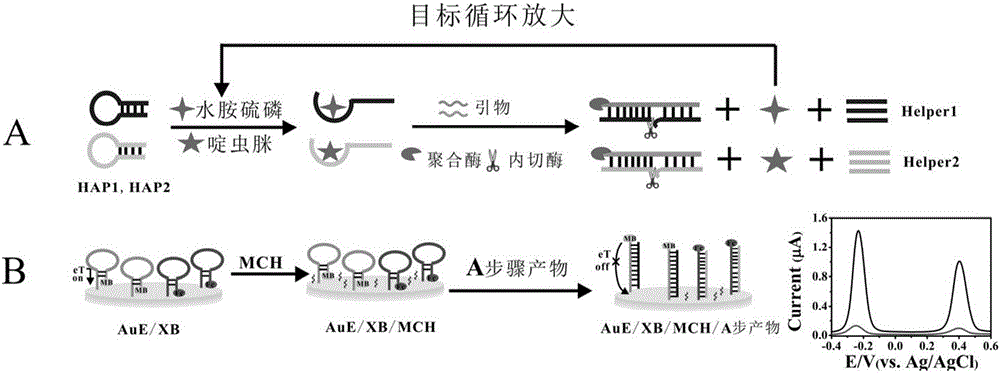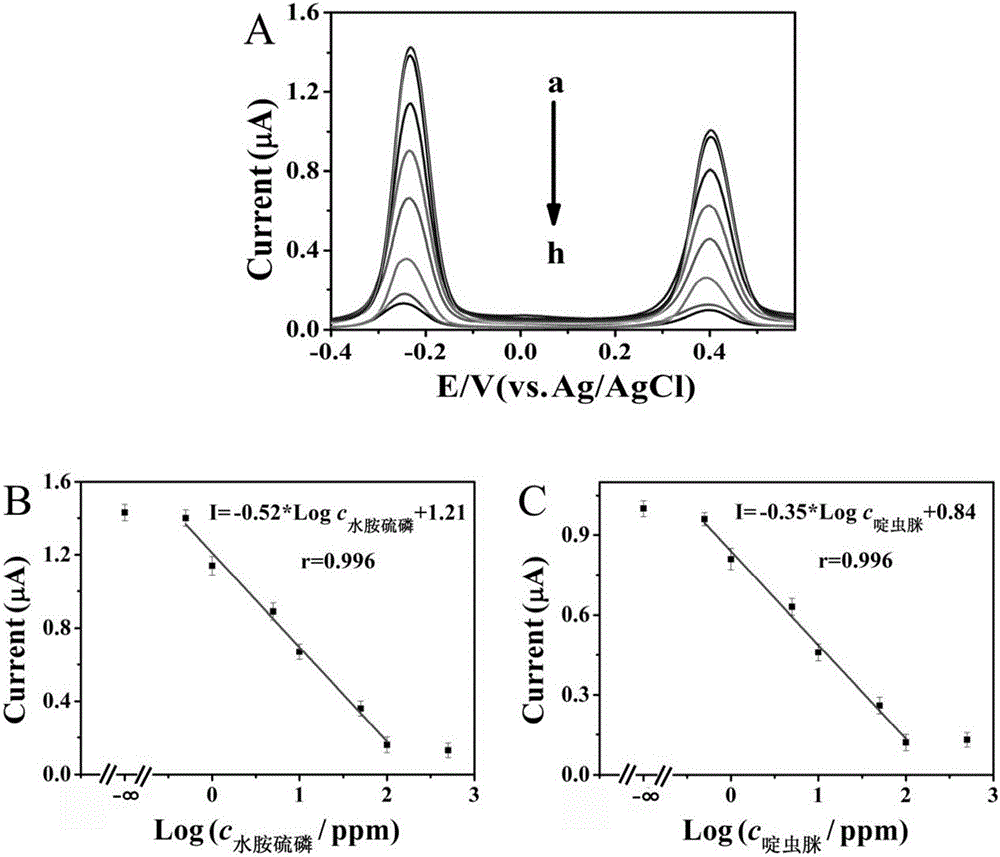Electrochemical sensor for detecting isocarbophos and acetamiprid at same time and method system of electrochemical sensor
A technology of isocarbophos and acetamiprid, applied in the field of sensors, can solve the problems of complicated instrument operation and inability to achieve high throughput
- Summary
- Abstract
- Description
- Claims
- Application Information
AI Technical Summary
Problems solved by technology
Method used
Image
Examples
Embodiment 1
[0072] a. The gold electrode is first polished in the alumina slurry with a particle size of 0.3 μm and the alumina slurry with a particle size of 0.05 μm until it becomes a mirror surface, and the electrode is soaked in 20 mL of H with a volume ratio of 3:1. 2 SO 4 and H 2 o 2 In the mixed solution, wash thoroughly with ultrapure water after incubation for 20 min;
[0073] b. Add a total of 6 μL of XB solution (10 μM XB1: 2 μL and 10 μM XB2: 4 μL) onto the electrode surface treated in step a, and incubate at room temperature for 2 hours. The chain is fixed to the electrode surface.
[0074] c. Use MCH modification to block the non-specific binding sites, specifically: add 6 μL of 1 mM MCH solution to the electrode surface dropwise, incubate for 30 min, and wash with PBS.
[0075] d, carry out homogeneous reaction, main steps are:
[0076] 1. Add 2 μL of 100 nM HAP1, 2 μL of 100 nM HAP2 and 20 μL of 1× Phi29 DNA polymerase buffer solution into the centrifuge tube, and inc...
Embodiment 2
[0084] a. The gold electrode is first polished in the alumina slurry with a particle size of 0.3 μm and the alumina slurry with a particle size of 0.05 μm until it becomes a mirror surface, and the electrode is soaked in 20 mL of H with a volume ratio of 3:1. 2 SO 4 and H 2 o 2 In the mixed solution, wash thoroughly with ultrapure water after incubation for 20 min;
[0085] b. Add a total of 6 μL of XB solution (10 μM XB1: 2 μL and 10 μM XB2: 4 μL) onto the electrode surface treated in step a, and incubate at room temperature for 2 hours. The chain is fixed to the electrode surface.
[0086] c. Modification of MCH to block unspecific binding sites.
[0087]d. The main steps in the homogeneous reaction:
[0088] 1. Add 2 μL of 100 nM HAP1, 2 μL of 100 nM HAP2 and 20 μL of 1× Phi29 DNA polymerase buffer solution into the centrifuge tube, add excess isocarbophos (500 ppb), and incubate at 37 ° C for 30 min;
[0089] 2. Continue to add 2 μL of 100 nM primer 1 and 2 μL of 100...
Embodiment 3
[0095] a. The gold electrode is first polished in the alumina slurry with a particle size of 0.3 μm and the alumina slurry with a particle size of 0.05 μm until it becomes a mirror surface, and the electrode is soaked in 20 mL of H with a volume ratio of 3:1. 2 SO 4 and H 2 o 2 In the mixed solution, wash thoroughly with ultrapure water after incubation for 20 min;
[0096] b. Add a total of 6 μL of XB solution (10 μM XB1: 2 μL and 10 μM XB2: 4 μL) onto the electrode surface treated in step a, and incubate at room temperature for 2 hours. The chain is fixed to the electrode surface.
[0097] c. Modification of MCH to block unspecific binding sites.
[0098] d. The main steps in the homogeneous reaction:
[0099] 1. Add 2 μL of 100 nM HAP1, 2 μL of 100 nM HAP2 and 20 μL of 1× Phi29 DNA polymerase buffer solution into the centrifuge tube, add excess acetamiprid (500 ppb), and incubate at 37 ° C for 30 min;
[0100] 2. Continue to add 2 μL of 100 nM primer 1 and 2 μL of 100...
PUM
 Login to View More
Login to View More Abstract
Description
Claims
Application Information
 Login to View More
Login to View More - R&D
- Intellectual Property
- Life Sciences
- Materials
- Tech Scout
- Unparalleled Data Quality
- Higher Quality Content
- 60% Fewer Hallucinations
Browse by: Latest US Patents, China's latest patents, Technical Efficacy Thesaurus, Application Domain, Technology Topic, Popular Technical Reports.
© 2025 PatSnap. All rights reserved.Legal|Privacy policy|Modern Slavery Act Transparency Statement|Sitemap|About US| Contact US: help@patsnap.com



